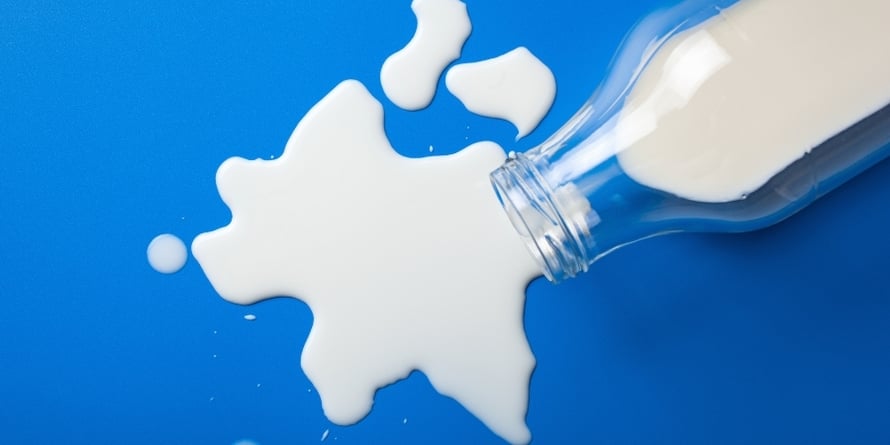What Is Lactose Intolerance?
Lactose is the main carbohydrate group found in dairy products. Many individuals experience unpleasant symptoms after consuming dairy, resulting in some people altogether avoiding dairy!
The sugars in lactose cause these unappealing symptoms, and they are commonly known as a digestive disorder called lactose intolerance. As we get older, our bodies produce less lactase, the enzyme in our small intestine that breaks down lactose sugars. When there are low lactase levels in your digestive system, your body will have difficulty breaking down lactose.
As a result, the undigested lactose, instead of being absorbed into the body, continues through the intestines. The sugars interact with gut bacteria, which triggers fermentation. Consequently, you will feel the abdominal pain and discomfort associated with lactose intolerance.
What Are The Symptoms of Lactose Intolerance?
If you are lactose intolerant, you may feel various symptoms, from mild to severe, which are often self-diagnosable.
- Abdominal cramps
- Bloating
- Diarrhea
- Nausea (vomiting in severe cases)
- Gas
Most symptoms become present about 30-60 minutes after lactose consumption. The discomfort and pain that follow lactose consumption typically last for around 48 hours or until the lactose exits your system entirely.
How Can I Prevent Lactose Intolerance?
Unfortunately, lactose intolerance is not preventable since it is an inherited genetic condition. The body significantly slows lactase production after infancy. For some people, this drop will be more drastic than for others. However, there are a few methods to alleviate symptoms.
The most effective way to prevent lactose intolerance is through dietary modifications. Replacing dairy products with lactose-free and dairy-free alternatives significantly reduces the chances of suffering from digestive issues. Besides minimizing lactose from your diet, the other option is to take lactase enzyme supplements to help your body digest lactose with meals.

What Foods Should I Avoid On A Lactose-Free Diet?
Many people actively omit dairy from their diet. However, lactose is hidden in other non-dairy foods.
- Milk & Cheese
- Butter (may be digestible for mild intolerance)
- Whey
- Meal replacements (powders and protein bars)
- Creamed vegetables
- Desserts (baked goods and ice cream)
- Bread, tortillas, crackers
- Cereals & Breakfast/Protein Bars
- Processed meats (bacon, sausage, hot dogs, and lunch meats)
- Some Canned Tuna (look for “hydrolyzed caseinate”)
- Vegetarian Cheeses (check for “Vegan” or “Dairy-free” to be sure)
Some foods, such as bread, tortillas, crackers, and other baked goods or flavored processed foods, may or may not contain dairy. Lactose is a common ingredient added to many products, so be sure to check nutrition labels.
To identify dairy-free products, go for vegan or kosher foods labeled ‘pareve.’ These products are always dairy-free and safe if you are trying to avoid dairy.
Names to Check Labels For And Avoid
- Milk
- Lactose
- Whey
- Curds
- Milk By-products
- Dry Milk Solids
- Nonfat Dry Milk Powder
What Foods Can I Eat On A Lactose-Free Diet?
A lactose-free diet is a fantastic way to practice a healthy lifestyle! The Blue Zones, regions of the world that are known for some of the world’s healthiest populations, reduce or remove dairy from their diets, or some opt for goat’s milk.
There are plenty of lactose-free foods to choose from, most of which can be found in a plant-based diet.
- Fruits and vegetables
- Soy-based foods (tofu, miso)
- Whole grains (buckwheat, barley, quinoa)
- Healthy fats (avocado, olive oil, coconut oil)
- Kefir yogurt
- Plain meat, seafood, poultry & eggs
- Legumes and pulses
- Nuts and seeds
- Alternative dairy products (plant-based products, fortified foods)
- Some dairy products like cream cheese and sour cream
At the grocery store, look for natural foods/ingredients. Raw foods are free from additives, which prevents you from consuming unnecessary preservatives and other sneaky undesirable ingredients.
Can I Still Eat Dairy When I Am Lactose Intolerant?
Yes, you can have lactose intolerance and still consume dairy! Though it is advised to avoid dairy, there are some forms you can still include in your diet. Lactose may appear in insignificant amounts in some dairy products, making them acceptable for most with lactose sensitivities when eaten in moderation and watched closely.
Cultured or fermented dairy products, such as yogurt and cheese, contain minimal amounts of dairy; the culturing process pre-digests the majority of lactose. Also, in processes such as cheesemaking, much of the whey and lactose contents are removed as the dairy product is being processed.
- Probiotic Yogurt
- Kefir & Quark
- Aged, Hard Cheeses (ex: swiss, feta, parmesan)
- Heavy Cream
- Cream Cheese
- Sour Cream
- Ghee
Another possible choice of safe dairy is goat’s milk. Goat’s milk does not contain nearly as much lactose as cow’s milk, which makes it more digestible if you have a mild intolerance. However, consider omitting foods with lactose completely if you are severely intolerant.
If you are lactose intolerant and choose to continue consuming dairy, ask your doctor about trying a lactase enzyme -- these tablets can facilitate the breakdown of lactose during your meal.
How Can I Get Calcium and Vitamin D Without Dairy?
Dairy provides your body with important nutrients, such as calcium and vitamin D. Calcium promotes bone growth and strength, and Vitamin D aids in the absorption of calcium.
When eliminating dairy from your diet, make sure to find alternative calcium and vitamin D sources. You can talk with your doctor about dietary supplements and include more foods that are high in calcium into your diet.
Plant-Based Foods That Are High In Vitamin D
- Tofu
- Fortified dairy-free milks (Soy, Almond, Rice)
- Fortified orange juice
- Fortified cereals
- Mushrooms (maitake, portobello, chanterelle, oyster)
Two other non-food sources of vitamin D are sunshine and supplements. You can spend a few minutes outdoors to soak in the sun and consult your doctor on the proper supplements for your diet!

Plant-Based Foods That Are High In Calcium
- Leafy green vegetables
- Tofu & Edamame
- Broccoli
- Brussel sprouts
- Legumes & Beans (Garbanzo beans/chickpeas, Black-eyed peas, Lentils)
- Juice (orange and apple)
- Almonds & Brazil nuts
- Seeds (especially poppy, sesame, celery and chia seeds)
- Amaranth
- Rhubarb
- Figs
- Spirulina
Another notable source of calcium is Maca Root, a radish-like plant grown in the mountainous regions of Peru. Well-known for its medicinal properties, Maca Root has become a popular plant-based product for extra nutrients.
What Are Some Dairy-Free Milk Alternatives?
Dairy-free milk is produced from a variety of natural ingredients. Each type differs in taste and nutritional value, but there is no right or wrong choice in which dairy-free milk you choose. Try them all and go with the option that best satisfies your palate and dietary needs!
- Soy Milk: high protein content, slight bean-like taste, creamy texture
- Almond Milk: subtle almond flavor and smooth texture
- Oat Milk: a mild sweetness, in-between creamy and watery texture
- Coconut Milk: rich coconut taste, higher in fat content than other dairy-free milks
- Hemp Milk: high omega-3 fatty acids content, provides great health benefits
- Macadamia Milk: tastes similar to almond milk, thick consistency
- Rice Milk: sweet taste, water-like consistency, low protein levels
- Cashew Milk: mild nutty flavor, high in calcium, popular with paleo diet
- Sesame Milk: great source of calcium, thick and smooth texture
- Flaxseed Milk: earthy flavor, medium thickness
Want To Make Your Own Dairy-Free Alternatives?
There are plenty of delicious recipes for dairy alternatives. Cooking up your own dairy-free dishes is a fun way to learn about your diet!
- Dairy-Free Cashew Cream Cheese
- Dairy-Free Homemade Yogurt
- Dairy-Free Ranch Dressing
- Dairy-Free Sour Cream
- Vegan Feta Cheese With Tofu
Conclusion
Accommodating lactose intolerance may seem daunting at first; however, there are various measures you can take to prevent a drastic lifestyle change. With the abundance of dairy alternatives being made from plant-based ingredients, you can easily follow a delicious and healthy lactose-free diet and still eat all your favorite foods!
Do you plan on switching to a lactose-free and dairy-free lifestyle? Let us know your struggles or concerns in the comments below, or contact us directly. Please do not hesitate to reach out for further questions about adopting a more plant-based diet -- health is wealth and we all deserve to feel our best!
Choosing a healthy plant-based and vegan diet is most beneficial when it comes to:
-
Higher levels of energy;
-
Improved sleep;
-
Aids in energy and overall happiness;

-
Provides a sense of comfort and relief;
-
Could prevent major diseases such as obesity and diabetes;
-
Accomplish weight loss and management; and
-
Improves mental and cognitive functioning.
Resources
Brabaw, K. (2016, May 18). 6 dairy foods that don't affect lactose intolerance.
Cahn, L. (2019, December 17). We found the best dairy-free milk alternatives.
Fisher, R. (2018, February). Eating, diet, & nutrition for lactose intolerance.
Leech, J. (2018, September 24). 9 evidence-based health benefits of kefir.
Link, R. (2020, March 24). Lactose-free diet: Foods to eat and avoid.
Mayo Clinic Staff. (N.d.). Lactose intolerance.
N.d. (N.d.). Calcium and strong bones.
N.d. (N.d.). Health benefits.
Toups, K. (2018, April 3). Vitamin D sources for vegans and vegetarians.



















